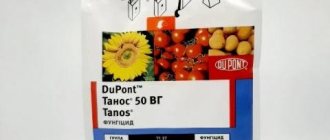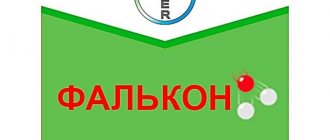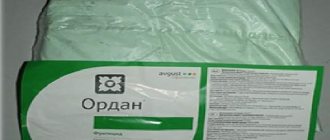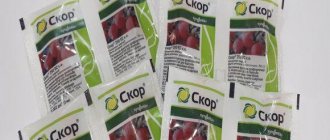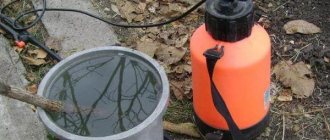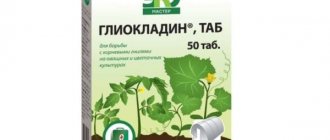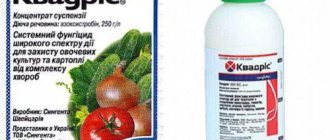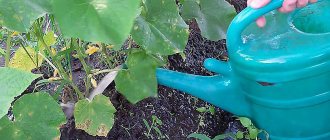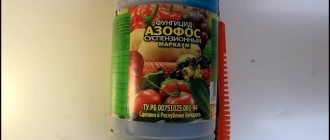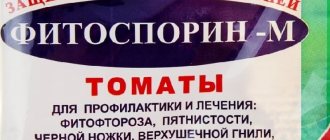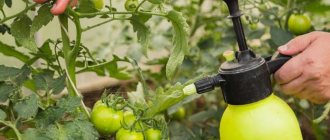Composition, release form and mechanism of action of the drug
It is intended for use on an industrial scale in gardens and private household plots. The composition contains cyprodinil (in a volume of 750 g per 1 kg), which is an anilinopyrimidine. Horus fungicide is manufactured by Syngenta in the form of water-dispersible granules, in packages weighing 1 kg, 1-3 grams.
The contact-systemic fungicide penetrates well into plant tissue; action is possible already at a temperature of 5°C. The beginning of the effect is 2-3 hours after spraying, the therapeutic effect is achieved after 36 hours, the time during which the protection continues is 7-10 days.
Subject to the rules of use and the correct dosage, it has excellent selective toxicity to the fungi against which it is designed. The most pronounced effect is achieved if the drug is used at the beginning of the disease, and not when it is in an advanced form.
Description of the active component
The active ingredient of the fungicidal agent is cyprodinil. The chemical group of the compound is considered to be anilinopyrimidine.
The amount of cyprodinil is 750 g in one kg of the Horus preparation (fungicide). The instructions classify the active substance in the third toxicity class according to the WHO classification.
Being a modern pesticide, the medicine is aimed at combating fungal pathogens, mostly for preventive purposes. The substance inhibits amino acid biosynthesis, which contributes to disruption of the life cycle of the infectious agent during the growth of the mycelium and during entry into plant cells. An important feature of the drug is its effect on the wintering stage of pathogenic fungi of the classes Ascomycetes, Deuteromycetes and some species of Basidomycetes.
Cyprodinil prevents the germination of fungal hyphae in the tissues of only young leaves, which limits its use in adult plants. This fungicide is unlikely to neutralize a heavily infected seedling.
Advantages and disadvantages of the product
Advantages of the drug Horus:
- performance;
- the fungicide is active even at low positive temperatures, therefore it is suitable for treatment in early spring and late autumn;
- non-toxic to cultivated plants;
- is compatible with other pesticides;
- economical to use and inexpensive;
- It is almost not absorbed into the soil and groundwater.
Disadvantages of the drug Horus: at temperatures above 25˚C, the effectiveness of the drug decreases, so it will not work in the summer heat. It does not penetrate old leaves as well as young ones, so it is recommended to treat trees or bushes at the beginning of their growing season.
Rose processing
Plants are treated with various pesticides to prevent powdery mildew and other fungal diseases. Typically, roses are treated with Horus-fungicide until buds appear and the ambient temperature reaches +10°C. The solution is prepared with 10 liters of water.
Read also: The best varieties of cucumbers for the Moscow region for open ground
In the future, a combination of several fungicidal agents is used. For medicinal purposes, the flowering bush is sprayed with a mixture of Horus and Aktara preparations.
For powdery mildew, good results are obtained by simultaneous treatment of roses with several medications, which include the fungicides “Horus” and “Aktara”, chelated microelements, and the drug “Adhesive”. All of the above drugs are diluted together in 10 liters of water. Spraying should be done in the evening.
Preparation of solution and dosage
Fungicide granules are highly soluble in water. Prepare a fungicidal solution before use; it is not stored for longer than a day. How to cook:
- Pour water into the sprayer tank, filling it 1/3 full.
- Pour in as many granules as required according to the instructions for the plant being treated.
- Stir thoroughly until they dissolve.
- Add the remaining water and stir again.
How much Horus you need to take depends on the pathogen and the type of crop being treated.
Precautionary measures
The low mobility of cyprodinil in a humid environment makes it relatively safe for humans. The permissible operating time is determined by the shelf life of the tank solution - 2 hours. A simplified PPE kit for working with Horus can be used with a petal respirator, see fig. It is highly advisable to spray in cloudy weather, as this enhances the effectiveness of the drug and the susceptibility of pathogens to it.
A set of personal protective equipment for working with the drug Horus
General precautions are standard: do not drink, do not eat, do not smoke while working. Pregnant and lactating children, allergy sufferers, patients or those with skin diseases should not be closer than 15 m to the treated area. If you feel unwell, stop working immediately.
First aid measures are also usual: take a glass of water with 2-4 activated carbon powders. Wait 3-5 minutes, induce vomiting and consult a doctor.
Chorus is moderately toxic to aquatic organisms, so it can be used at a typical sanitary distance from water sources and reservoirs of 50 m. The flight limit for bees for Chorus is 12 hours; apiary protection zone 1.5 km.
When and how to use Chorus
The drug is suitable for use throughout the entire growing season of plants, but to achieve the best effect, they need to be treated when they are in a certain phase of development.
Fruit trees
The fungicide is used against diseases on stone fruits: monilial blight, cleasterosporia blight, coccomycosis and various fruit rots. Dosage – 3.5 g per 10 l (for monilial burns 2-3.5 g per 10 l).
Processing time:
- For clyasterosporiasis, coccomycosis - when a lesion is detected and after another 1-1.5 weeks.
- From monilial burn - until the flowering phase and again after 1-1.5 weeks.
- For fruit rot - when a lesion is detected, then 2 weeks before harvesting.
The number of treatments is 2, the waiting period before collecting fruits is 15 days.
Fruit trees such as apples and pears are treated for scab, Alternaria blight, moniliosis and partly powdery mildew. Dosage – 2 g per 10 l, consumption – 100 ml per 1 sq. m. The number of sprayings is 2, the time of the first occurs at the “green cone” stage - “end of flowering”, the second - after 1-1.5 weeks. The waiting period is quite long - 28 days.
Coniferous trees
Preventative spraying is done in April, when shoots begin to grow - against Schütte rust and Hermes scale insects. Chorus is diluted in a concentration of 3 g per 10 l. They are not used separately, but with Enzhio (3.6 ml), Plantafol 20.20.20 (25 g), Brexil Mix (20 g) and adhesive.
Strawberries and wild strawberries
Strawberries are sprayed with Horus against gray rot, powdery mildew, white and brown spots 1 time: before or after flowering. In the first case, take 6 g per 5 liters and spend this volume per 1 hundred square meters, in the second - 3 g per 5 liters.
Grape
The vine is sprayed against gray and white rot, olive mold, watery rhizopus and black aspergillus berry rot. Dosage – 6 g per 5 l, liquid consumption – 100 ml per 1 sq. m. Carry out a maximum of 3 treatments of grapes with Horus, the 1st during budding, the 2nd before the berries are closed in tassels and the final one when they begin to color. Waiting period – 1 week.
Scope of application
Horus is a fairly specialized drug: it is active against fungi of actinomycetes (Ascomycetes), deuteromycetes (Deuteromycetes) and certain species of basidymycetes (Basidiomycetes). However, they are the ones that cause the greatest losses in harvest volume and commercial quality of the crop.
Signs of diseases of fruit plants, from which Horus fungicide helps
At the initial stages of the disease, Horus allows you to cope with such fungal diseases of fruit and berry crops as (see also Fig.):
- scab of apples and pears;
- moniliosis burn (moniliosis) of pome and stone fruits (plums);
- powdery mildew of stone fruits, berries and peaches;
- peach leaf curl;
- and also, with less success, other fruit rots and blights.
Note: of course, at the stages of the disease shown in Fig. for clarity, it is useless to treat the fruits. And the drug will not help, and they are no longer suitable for food anyway.
Horus and mildew
The manufacturer also positions Horus as a remedy for downy mildew of grapes - mildew. see picture:
Downy mildew of grapes - mildew
Perhaps, in the specific conditions there (Syngenta Crop Protection Co. Swiss company): coolness, clean air, high insolation, Chorus against mildew and is effective. But in the lowland viticulture regions, following east from Hungary, many winegrowers note: the use of Horus reduces plant immunity. Once you spray it, get ready to do the same every 10 days and fight other diseases. Perhaps this is due to higher summer temperatures, less active insolation due to dust in the air, and a smaller difference between day and night temperatures than in the mountains. All this contributes to the rapid development of pathogens, but the activity of the drug is the opposite. In any case, the fact that Horus is above +25 and against mushrooms that have formed mycelium is useless. Other fungicides have proven more effective for grapes, see video:
Video: about fungicides for grapes
Reviews of the drug Horus
The effectiveness of this fungicidal agent is evidenced by the reviews that gardeners leave after using it.
After spraying the apple trees with Horus anti-scab twice, as required according to the instructions, they disappeared from showing any signs of the disease. There are no noticeable spots on leaves, branches and, most importantly, fruits. The effectiveness of this fungicide has been proven in practice. Ivan
If you use Horus for prophylaxis, you will not need treatment afterwards. One or two treatments are enough to destroy fungi that have not yet had time to harm the plants. Sergey
I use Horus to treat garden trees and strawberry beds. This allows you to protect the crop from damage by fungi and protect the plants themselves. A 1 kg package is enough for 3 years of use if stored correctly. Oleg
Compatibility with other fungicides
"Horus" is compatible with other fungicides, however, before use, manufacturers advise carrying out a preliminary check. To do this, prepare solutions from “Horus” and the desired product and combine them, mixing thoroughly in a transparent container. The fungicide mixture is left for 2-3 hours and then checked for the presence of sediment. If the sediment is minimal and does not differ from normal, the drugs are compatible. Many gardeners use “Horus” together with “Aktara”, “Skor”, “Sumition” and “Topaz”.
Spectrum of action
Most often, Horus is used for gardening and processing fruit trees, berry bushes, strawberries, wild strawberries. Unlike other similar fungicides, the Swiss drug effectively and very quickly destroys pathogenic fungi.
Read also: Kharitonovskaya cherry: variety description, reviews
Chorus is effective in cases where the disease of fruit trees or other plants is caused by this number of infections:
- scab;
- powdery mildew;
- Clusterosporiosis;
- moniliosis of stone fruit crops;
- fruit rot;
- gray rot;
- white and brown spots;
- mildew;
- leaf curl;
- Alternaria blight;
- oidium.
